The iPhone 6 Review
by Joshua Ho, Brandon Chester, Chris Heinonen & Ryan Smith on September 30, 2014 8:01 AM EST- Posted in
- Smartphones
- Apple
- Mobile
- iPhone 6
Battery Life
Battery life is undoubtedly one of the most important aspects of any smartphone. However, battery life is an enormous subject, and while it may seem simple on the surface there’s a great deal of underlying complexity. In order to try and cover the full breadth of use cases, we start with our baseline test, which is now the web browsing battery life test. In order to try and control for extraneous variables and get a good relative comparison, we standardize all displays to 200 nits on a full white display.
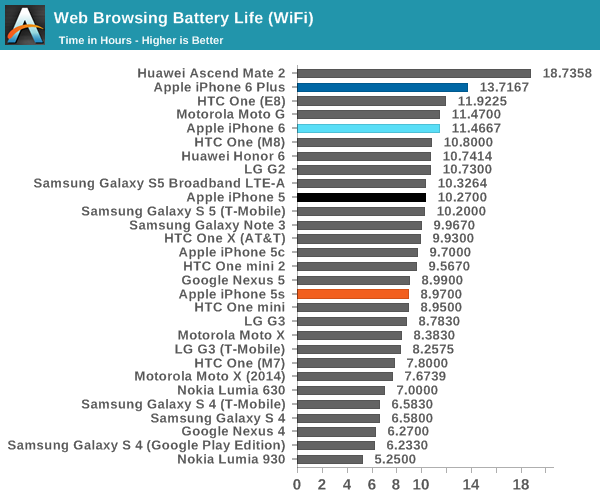
Our first test is in WiFi web browsing. As we can see, the iPhone 6 puts up a surprising showing for a phone with such a small battery. If anything, it seems that Apple leaned towards the conservative side in their advertised numbers as we managed to get higher than expected battery life. It may seem strange that the iPhone 6 achieves such a strong showing despite the small battery, but this is because the test is designed to avoid penalizing a phone for having a faster SoC or data connection.

In LTE web browsing, we see the same story. The iPhone 6 is about equal to or better than the competition, which is in line with what we would expect given the cellular architecture. In the case of the iPhone 6 and most other flagship smartphones this year, components such as Qualcomm’s QFE1100 envelope tracker, WTR1625 transceiver, and MDM9x25 modem have managed to make LTE power consumption approximately equal to WiFi power consumption. With the deployment of category 6 LTE and next generation RF components we could see LTE battery life exceed WiFi battery life.
While the web browsing test gives us a good picture of battery life in display-bound tasks, intensive use tends to be more SoC-bound. In order to see how phones compare in SoC-bound workloads, we turn to GFXBench, which has an infinite looping test. This test also provides a good idea of nominal performance. Unfortunately, for now we cannot report an accurate Basemark OS II battery life score as the test will stop when low battery notifications pop up on the screen. We are currently investigating methods to bypass this issue and report a final score in the near future.
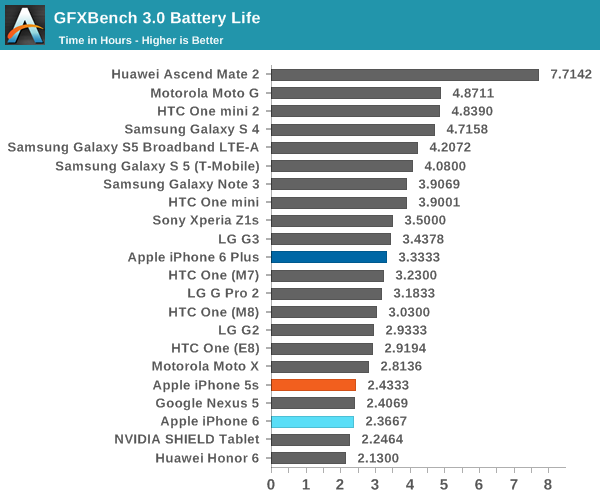
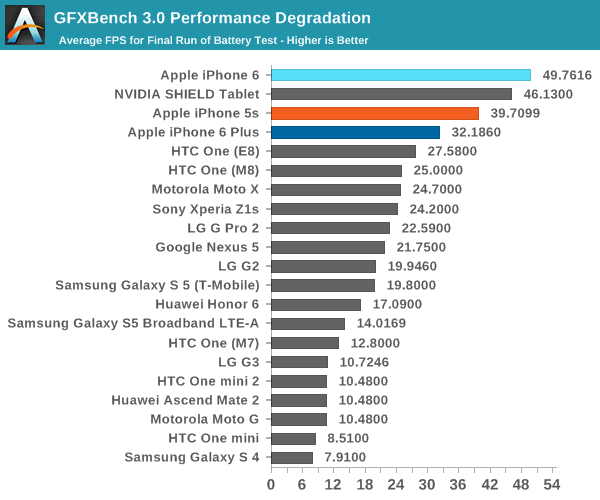
In the GFXBench test, at first it seems that the iPhone 6 is one of the worst for battery life under sustained load. However, once we look at the performance degradation over time it makes a lot more sense. This seems to be the type of workload that Apple referenced in their presentations, because this is the first phone I’ve seen that successfully does a full rundown without actually throttling. Of course, this does come with high skin temperatures. The phone definitely gets hot, but not uncomfortable. Using a FLIR camera, I saw peak temperatures of around 43 degrees Celcius, so it definitely doesn't exceed 50C in most conditions.
Normally, I would expect a 4.7” class smartphone to need a battery around the size of the HTC One (M7) or Motorola Moto X (2013) to keep pace with phones like the One (M8) and Galaxy S5, but Apple has pulled it off with a battery that is much smaller. There are two key factors that we can point to in this case. The first is the display, which can avoid pushing the LED backlight towards the higher current region that is much less efficient. This is because the amount of light-blocking circuitry is reduced and the active area of the display can be higher. The second aspect is the SoC, which is on a lower power 20nm process node. While TSMC’s 20nm process doesn’t have FinFET, improved silicon straining and high K metal gate make it possible to drive down active power and leakage when compared to 28nm processes. It’s also likely that the A8’s architecture is more efficient than other SoCs we’ve seen this year. However, it's important to note that without a capacitance and voltage table or something similarly concrete we can't really prove this statement.
Charge Time
While battery life determines the time spent away from a charger, the time spent attached to a charger is just as important. Even if most people charge their phones at night, there are plenty of cases where people don't have at least five hours to spend charging their phone. For example, forgetting to plug the phone into a charger before going to sleep or charging a phone between connecting flights are all times when charge time becomes crucial. In order to properly test for charge time, charge time is measured as the time from when the phone is connected to the charger to the time when the A/C adapter reaches its lowest power state with the phone still connected.
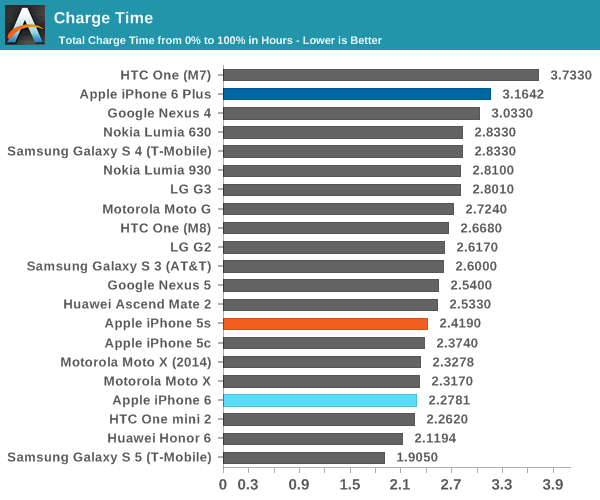
As you can see, the iPhone 6 performs reasonably well, and ends up in the same range as the iPhone 5s. The iPhone 6 Plus ends up on the high side because it ships with the same power adapter as the iPhone 6, which can provide a maximum of one amp at five volts.
Fortunately, based on the USB device information for the phones, both the iPhone 6 and 6 Plus support charging with power adapters like the iPad charging block that can provide up to 2.1 amps at five volts. Using one of these chargers will dramatically reduce charge time on the new iPhones, and it's a very worthwhile investment (assuming you don't already have an iPad) for the iPhone 6 Plus in particular.


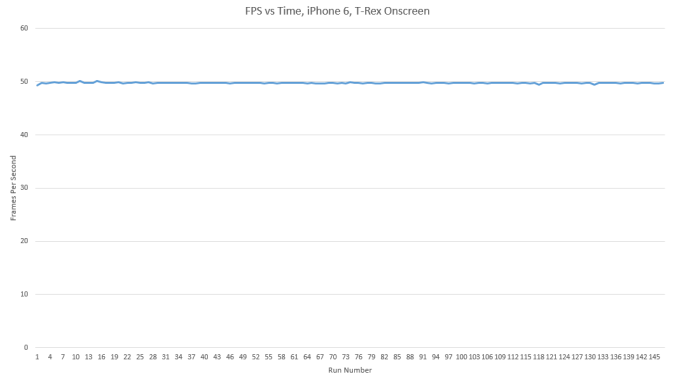
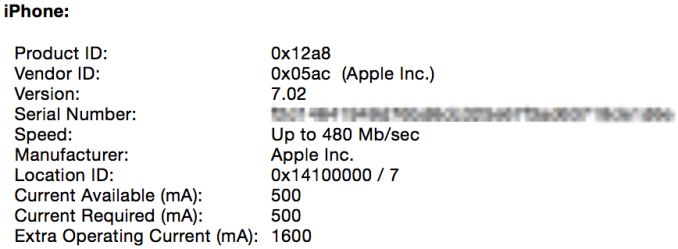








531 Comments
View All Comments
elajt_1 - Friday, October 3, 2014 - link
(@melgross) And to call you one would be an insult to an idiot.Apart from the rage, I think it was he made some valid points.
Jimrod - Tuesday, September 30, 2014 - link
You mad bro?rational_wannabe - Tuesday, September 30, 2014 - link
You have serious issues. So it's OK for Samsung to sell their plastic crap for the same amount of money? Nice way of rationalizing things...danbob999 - Tuesday, September 30, 2014 - link
Yeah it's OK since there is nothing wrong with plastic. It absorbs shock, is light and do not block wireless signal. Perfect material for a phone. It is also durable enough. How many people replace their phone because the plastic is cracked? Not much. People replace their phone either because the screen is broken, it was damaged by liquid or simply because it is too slow/old.Apple has been selling phones which are cheaper to produce for years at the same price (or higher) than the competition. Smaller phones tend to be cheaper, because the display is cheaper, the battery is cheaper, and the rest cost the same. So even by using plastic, Samsung phones cost more to produce so I fail to see how they can be labeled as "cheap".
blackcrayon - Tuesday, September 30, 2014 - link
Apple is spending far more in developing the phone in other areas though. Writing the OS, designing custom SoCs, etc.danbob999 - Tuesday, September 30, 2014 - link
Designing custom SoCs is an investment. It isn't supposed to raise the cost of the phone.Samsung also design some of its own SoCs and even manufacture them.
The OS is debatable. But from a hardware perspective Samsung phones (at least the high end ones) are definitely not cheap, even if they use plastic.
Parhel - Tuesday, September 30, 2014 - link
R&D should affect the cost of the product? That's not how it works . . .Parhel - Tuesday, September 30, 2014 - link
Ugh.. meant to say R&D "shouldn't". To state it plainly, R&D may be an investment, but it's still an expense. The cost needs to be recouped, and they make money by selling phones, so . . . you do the math.danbob999 - Tuesday, September 30, 2014 - link
Of course they have to make money. But spending more in software development, R&D or marketing doesn't make their phone any less "cheap". I was replying to someone saying that Samsung phones were "cheap" because they were in plastic. The fact is that Samsung phones tend to be more expensive than iPhones to make, because the cost of the components is higher, despite any savings made by using a plastic shell.akdj - Friday, October 3, 2014 - link
Only BECAUSE it takes my Note3 twice the cores, at twice the clock speed with three times the amount RAM to FINALLY close the gap on performance. Almost. My 5s is still quicker playing Asphalt8, manipulating photos, even rendering VIDEO! Most likely the latter because of the extreme lack of interet in the development community (other than game ports) to 'build out' apps and software. And that sucks! I love my Note 3--- coming from the original its a massive upgrade. That said, Samsung is using stock, off the shelf SoCs ....indeed 'produced' by them as they've got the capabilities to cook bake and roll out silicon BUT they've chosen to increase horsepower, drop the gearing ratios and add a stage III nirrous kit 'built' and low level programmed with basic ARM instructions and a radical slather of Peanut Butter JavaScript to wade through just for TouchWiz. By the time you open an app, you're at 85-90% RAM usage. I've got a N3. I like it and I'm not getting rid of it. It serves it's purpose for our business perfectly. But AS a business owner and one that relies on creative talent to make it 'work' I find your comment very VERY ill informed and 'ignorant' ...no to be a dick. But yes, R&D is definitely a percentage figured into the equation with BOM. As well, the software development, A8 & the second generation 64bit processor with a faster GPU, more efficient memory managment with the SoC 4mb buffer and iOS 8 itself are expenses. Paid to a LOT of talent! For crying out loud, they developed a new CODE! And a spectacular one at that! Free lessons are everywhere and if you're experienced, have a macbook laying around, download the latest XCode and you'll have Swift down in a weekend. Not to mentioned the low level 'Metal' instruction set to eliminate the OpGL ES overhead ...allowing developers 'direct' (hence, 'Metal') access to the GPU ...if you're at all curious on how incredible this development most consumers will NEVER know about ...check out Unreal 4's site, the UR4 engine and what they've done with Metal. You can download their patio presentation frim WWDC in the app store. It's absolutley amazing. Samsung's phones are spendy because they're licensing Wacom, using active digitizers few are able use (until this evolution, three's a charm I guess), massive batteries, a horrid looking bezel that's rigid for sure, but then again, this is the first I've seen people, on purposes bending phones, and that's not a real life issue or even concern. I shared earlier, somehow my nine year old son has managed to keep his iPod touch fifth gen in perfect non bent and scratch free condition. Two years. Lotsa boogers and bumps but no dents, no dings, scratches or 'display marks' without screen protection. Guesses can be made in physical pieces. Even how long (labor pricing) to produce a single unit. But development of actual silicon, low level optimization to your non fragmented operating system, 64bit technology 24 months ahead of the industry and obvious benefits from the 20nm A8. iOS 8 (and its counterpart more than ever, OS X 10.10) and its ability to aggregate our information across devices, handoff calls, emails, texts or whatever the hell you're doing on your iPad ....get distracted, fall out and when you turn your iMac or MBP on, there's the email you were working on. Ready for you to finish. The web page you were reading or the movie your were watching ...vice versa too. Start on your computer a doc, and open your iPhone, there'll be a small 'doc' icon signifying you're working on something and you're able to finish it here! Forget the phone downstairs, your in bed reading before sleep, phone rings...no worries. Answer it on your iPad. AirDrop between laptop, tablet and phone, MacPro and ipad....iPhone to your iMac, slick n quick.Of course, then there's the whole 'build quality' argument. Where designers, reviewers, and the public ALL Seem to agree. The iPhone SNOKES Samsung's BQ. Period. They're like jewelry, true and real 'art'. Each phone has been an engineering marvel. Samsung? Are you kidding me? Other than their goofy, curvy, earthy S3 baby blue tangent, their 'rectangle' phone lacks ANY design fundamentals much less achievements.
When you sell as MANY pieces as Apple does, costs come down. For the 'pieces'. But the machining process (2 year cycle) is entirely changed. Fusion welding and sapphire 'plants', robotics and laser/chamfered edging with incredible attention to detail are just a couple of the hundreds of THOUSANDS of re-tooling the facilities for the latest 'build'. And after a couple of hours today with the 6 & 6+ as we anxiously await ours, with an open mind (& as an ambidextrous user of Android and iOS Windows and OS X) --- NOTHING on the Internet does justice to the phone itself. It's. Absolutely. AMAZING!